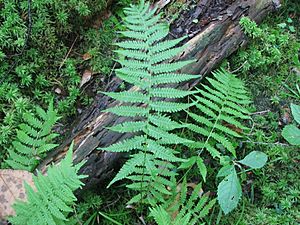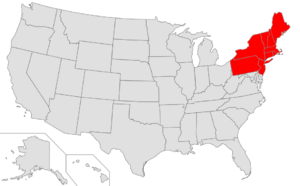Coryphopteris simulata facts for kids
Quick facts for kids Coryphopteris simulata |
|
|---|---|
 |
|
| In its natural habitat | |
| Scientific classification | |
| Genus: |
Coryphopteris_
|
| Species: |
simulata
|
 |
|
| Distribution in the Northeastern United States | |
| Synonyms | |
|
|
Coryphopteris simulata, also called the bog-fern or Massachusetts fern, is a type of fern. It grows naturally in the Northeastern United States. This fern is sometimes confused with other ferns like the silvery spleenwort or New York fern. This is because they look similar in shape and size.
Contents
What It Looks Like
The Coryphopteris simulata fern is a bright green color. Its main leaf, called a frond, can be about 61 cm (24 in) long. The stem of the frond is long and thin, about 20.3 cm (8 in) long. These stems are usually thin and might have small scales or hairs. The top part of the stem is yellow-green, and the bottom part is light brown.
The leaves of this fern are all similar in shape (monomorphic). They are also "pinnately compounded," meaning they have many smaller leaflets arranged like a feather. These leaves can be 10–40 cm (3.9-15.7 in) long and 7.6-15.3 cm (3–6 in) wide. The veins in the leaves usually do not branch, but some branching can be seen near the bottom.
This fern produces two kinds of leaflets: fertile and sterile. Fertile leaflets are those that can produce spores. Sterile leaflets do not. Both types of leaflets look similar. They are divided into about 15 to 18 smaller sections. These sections are long and narrow, especially closer to the main stem. Most leaflets stand upright, but the bottom ones point downwards. They are about 25–80 cm (9.8-31.5 in) long. The fertile leaflets are usually a bit longer than the sterile ones.
You can find round sori (which are groups of spore cases) on the underside of the fertile leaflets. These sori are covered by a pale tan, kidney-shaped cover called an indusium.
The fern's underground stem, called a rhizome, is thin and black with some scales. It spreads out widely and has many branches. Older roots are short, black, and thin. There are also many young, hair-like roots.
How It Grows
The Coryphopteris simulata is a perennial plant, meaning it lives for more than two years. It is also a forb or herb, which means it's a non-woody plant. Its shoots grow up from the rhizome, which is usually underground but can sometimes be at ground level. The leaves of this fern die and fall off during the winter. New spores are produced in the summertime.
About Its Name
This fern was first described in 1894 by George Edward Davenport. He named it Aspidium simulatum. Over the years, scientists have changed its genus name several times as they learn more about ferns. It has been called Thelypteris, Parathelypteris, and most recently Coryphopteris. Even today, there is still some discussion among scientists about its exact classification.
One special thing about this fern is its sweet smell. Because it looks similar to other ferns like the marsh fern and New York fern, people often don't notice it or confuse it with them. This fern is also quite rare, and its shape can vary, which adds to the confusion.
Where It Lives
The Coryphopteris simulata fern grows on land. It is found in Eastern Canada (like New Brunswick and Quebec) and in many parts of the United States. This includes the North-Central states (like Wisconsin), the Northeastern United States (like Massachusetts and New York), and the Southeastern United States (like Maryland and Virginia). It is generally an uncommon plant. An unusual patch was even found far away in southwestern Wisconsin.
Its Home Environment
This fern grows in shady, wet areas like wetlands and bogs. You can find it in swamps with cedar, spruce, larch trees, and sphagnum moss. It likes to grow among bryophytes (like mosses), which give it shade and protection from the sun. It prefers soft, spongy, moist, and acidic soil.
Images for kids


